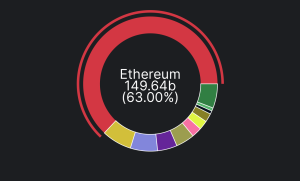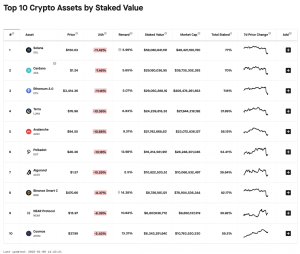
Decentralized application stage Ethereum actually has the most Web 3.0 engineers, yet it’s everything to play for with rivals becoming quicker.
The information comes from research firm Electric Capital which delivered a report this week into the Web 3.0 improvement environment.
Electric Capital found that in excess of 4,000 designers effectively work on Ethereum each month.
For correlation, only 680 designers effectively work on Bitcoin each month. It’s a gigantic dissimilarity, however it merits recalling that Ethereum is undeniably more complicated as a decentralized application (dapp) stage as well as being a computerized money.
A lot is said about the “network impact” of Ethereum, which is fundamentally only its first-mover advantage. Ethereum has, overwhelmingly, the most dapps and clients.
Graciousness of DefiLlama, simply investigate the level of “all out esteem locked” in Ethereum’s decentralized money (defi) biological system contrasted with different stages:

Ethereum actually has the most Web 3.0 designers, yet equals are becoming quicker
By Ryan Daws | sixth January 2022 | TechForge Media
Classes: Blockchain, Gaming, Metaverse, Open Source, Platforms,
Ryan is a senior proofreader at TechForge Media with more than 10 years of involvement covering the most recent innovation and meeting driving industry figures. He can frequently be located at tech meetings with a solid espresso in one hand and a PC in the other. Assuming it’s nerdy, he’s presumably into it. Track down him on Twitter: @Gadget_Ry
Decentralized application stage Ethereum actually has the most Web 3.0 engineers, however it’s everything to play for with rivals becoming quicker.
The information comes from research firm Electric Capital which delivered a report this week into the Web 3.0 improvement biological system.
Electric Capital found that in excess of 4,000 designers effectively work on Ethereum each month.
For examination, only 680 engineers effectively work on Bitcoin each month. It’s a gigantic divergence, yet it merits recalling that Ethereum is undeniably more mind boggling as a decentralized application (dapp) stage as well as being a computerized money.
A lot is said about the “network impact” of Ethereum, which is fundamentally only its first-mover advantage. Ethereum has, overwhelmingly, the most dapps and clients.
Civility of DefiLlama, simply investigate the level of “absolute worth locked” in Ethereum’s decentralized money (defi) biological system contrasted with different stages:
Designers are normally tempted towards where the movement is, and this moment that is Ethereum.
In any case, Ethereum’s position isn’t be guaranteed to as get as it could appear. The entire space is as yet little contrasted with the incorporated elective administrations that it’s endeavoring to disturb and Ethereum has been tormented by sluggish exchange rates and high charges.
Contending blockchains were worked starting from the earliest stage to address large numbers of Ethereum’s concerns. Ethereum 2.0 ought to fix the stage’s weaknesses, yet it very well may be a long time before it’s completely sent.
Assuming you’re an engineer that needs versatility today without depending on a “layer two” arrangement like Polygon, you want to check the opposition out.
Polkadot, an opponent blockchain stage planned by Ethereum fellow benefactor Gavin Wood, has around 1,500 month to month dynamic designers. Solana and Cosmos, two other promising adversaries, have around 1,000 each. Close, Avalanche, Cardano, and Tezos all have in excess of 250 dynamic designers.
“Polkadot, Solana, NEAR, BSC, Avalanche, and Terra are becoming quicker than Ethereum did at comparable places in its set of experiences,” composed Electric Capital.
Between December 2020 and December 2021, the analysts found that Solana’s month to month dynamic engineers developed by 4.9 times, NEAR by 4x, and Polygon more than 2x. Cardano and Cosmos were somewhat behind with a 90 percent and 70 percent expansion, individually. Ethereum, in the mean time, developed by 42%.
Marking Rewards shows how much worth clients are “marking” to assist with getting their number one chains:

It’s a genuinely decent sign of client interest in each undertaking and shows Solana serenely in front of Ethereum 2.0, while Cardano is just barely about in runner up. Regardless of Polkadot’s moderately huge number of month to month dynamic designers, it’s in 6th spot behind Terra and Avalanche which are both arising as major defi players.
The uplifting news for all Web 3.0 fans is that, across all chains, development is going on at a quick speed. Energizing applications are currently arising past defi in regions like the metaverse, NFTs, gaming, DAOs, and that’s just the beginning.
